| October
4, 2006
Hello from Nova Scotia – Driving on
the Evangeline Trail from Annapolis Royal to Yarmouth
I had really enjoyed my breakfast at the Garrison
House B&B in Annapolis Royal,
but my second day of explorations had begun and no time was to be
wasted. I had a big drive ahead of me and my first quick stop was
at Fort Anne where I met Alan Melanson, the Parks Canada Ranger
and expert historian who had guided the entertaining and informative
Candlelight Graveyard
Tour last night.
He had promised me yesterday that he would show me the Fort Anne
Heritage Tapestry, a collective effort of more than 100 volunteers
who brought 4 centuries of history to life. 95 different colours
of Persian wool were interwoven and stitched to form a historic
tableau that is unique in Canada. It is about 18 feet long and 8
feet high and even Queen Elizabeth herself, on one of her travels
to Canada, made a few official stitches in this tapestry. Alan himself,
as a 9th generation Acadian, added to the artwork by stitching a
few drops of red blood in the section on the Acadian deportation.

Alan points out the Queen's stitches
Pressed for time I thanked Alan and made my way to another unique
facility in Annapolis Royal: the Tidal Power Generation Station.
Les West who works in the tourism office located on the main floor
of the power plant, gave me a quick half hour introduction to the
only tidal power generating plant in Canada, one of only two in
the world. Les explained that Nova Scotia uses a variety of electricity
generating methods, including oil, gas, hydro, wind and tidal power.
Its topography with its low-lying hills is not perfectly suited
for hydro generation, so during the 1970s, when oil prices were
really high, the government devised plans to take advantage of tidal
energy.
The Annapolis Royal site was chosen due to its high tides and a
permanent causeway was built across the Annapolis River. A stainless
steel straight-flow turbine was installed by a Swiss engineering
firm and from 1980 onward tidal energy was taken advantage of. Today
the Annapolis Royal Tidal Generating Plant produces enough energy
for about 4500 homes in the area. More power is brought in as back-up
when the tidal power plant does not produce enough energy.
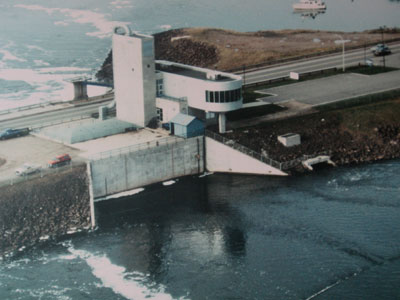
The Annapolis Royal Tidal Generating Plant
Les also explained that the construction of the power plant and
the permanent barrier in the river has had significant effects on
the eco-system in the Annapolis River: the river has silted up considerably
and sediment builds up at a rate of about 6 inches a month. Because
of the significant ecological consequences of this construction
it is unlikely that a similar project will be built in the future.
However, electricity-generating projects that do not create permanent
barriers may still be considered in areas of strong tidal current
flows. Lessons have been learnt from the realization that even though
tidal power in theory is a renewable, green source of energy, the
design of the power plant can still have a major effect on the local
environment.
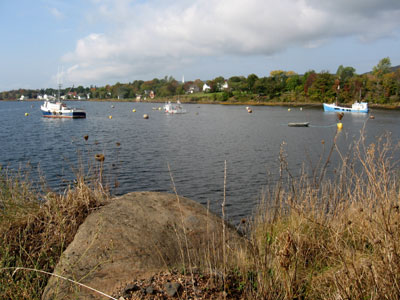
Scallop boats in the Annapolis River
It was time to say goodbye to Annapolis
Royal after an interesting 20 hours or so in this historic region
and make my way westwards towards the Bear River Heritage and Cultural
Center where I would receive an interesting introduction to Nova
Scotia’s Mi’kmaq culture (written up in a separate article).
I set off on my coastal drive through rolling green hills whose
colours were just changing. Tidy little villages such as Upper Clements
and Clementsport were flying by until I turned northwards into the
Bear River reserve for my visit at Bear River Cultural and Heritage
Centre.
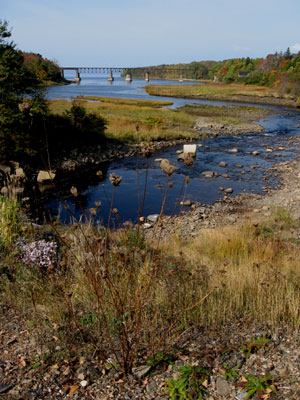
The beautiful Bear River
After my two hour introduction to native culture in Nova Scotia
I set off again on my westward drive and enjoyed the beautiful views
along the meandering Bear River. I linked up with the coastal road
again and slowly made my way into Digby, a local fishing town and
a major settlement in the area. I parked my car and decided to take
a quick stroll through Digby on a beautiful sunny and warm afternoon.
Digby was settled in 1783 by the United Empire Loyalists under
the leadership of Sir Robert Digby. The town’s economy is
based on two major industries: fishing (Digby is famous for its
scallop fishing fleet) and tourism. As early as the late 1920, a
big resort called The Pines was built on the outskirts
of town, and to this day Digby is a popular tourist destination.
One of the major attractions in the area are the world’s biggest
tides in the Bay of Fundy. Digby also hosts an annual Scallop Days
Festival which introduces tourists to the history and heritage of
the town.
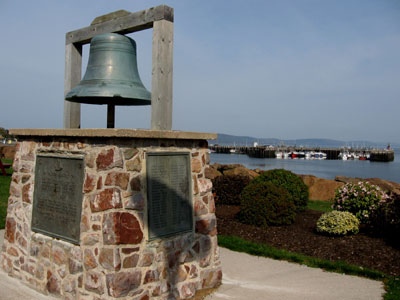
Waterfront view in Digby
I strolled along the waterfront and noticed the many waterfront
restaurants that specialize in so many of Nova Scotia’s marine
delights including lobster, crabs, shrimps, scallops and various
types of fish. I had a quick soup and salad at the Shoreline Restaurant
and enjoyed my lunch with a nice view of the waterfront. Less than
an hour later I hopped back into my car to continue my journey to
Yarmouth.
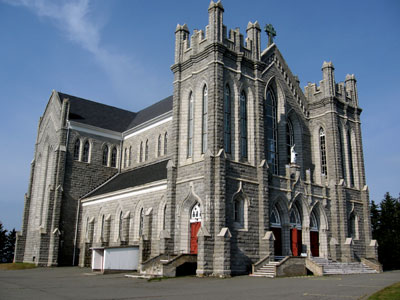
The granite church of St. Bernard
The coastal road turned into a highway which I exited at St. Bernard
where one of Nova Scotia’s biggest stone churches is located.
I had entered the St. Marys Bay area which ended up being the final
settlement area for many of the Acadians, French settlers who had
been deported as part of the Great Expulsion
in the mid 18th century. After having been deported all over North
America, many Acadians returned to Nova Scotia over the following
decades. Although they did not settle in their original agricultural
farming areas, as they had been assigned to English settlers, many
Acadians located their permanent residences along the northwest
shore of Nova Scotia and became fishermen.
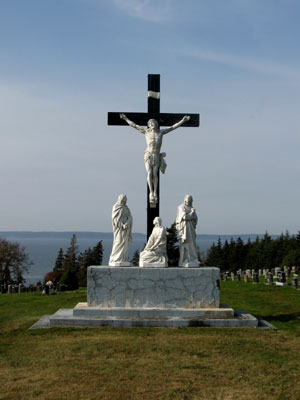
Crucifix behind St. Bernard's Church
The Acadian settlers were devout Catholics and many villages boast
magnificent churches, many of them made from wood. One of the finest
examples is St. Mary’s Church at Church Point, the largest
wooden church in North America. Its bell tower is an impressive
56 metres (185 feet) high. The Centre Acadien de Université
Sainte-Anne is located right next to this church, and it is Nova
Scotia’s only French language university, right in the heart
of Acadian culture.

St. Mary's Church
The entire region is called Clare and denotes the Acadian heritage
area. Acadian culture is celebrated every year in August when the
world’s oldest festival, the Festival Acadien de Clare, celebrates
Acadian heritage, traditions, food and music. The Musique de la
Baie festival takes place every year from April to August and celebrates
Acadian culture and folklore.
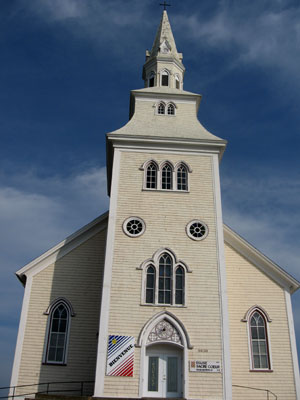
Sacre-Coeur Church
Further south, the village of Mavillette boasts a special attraction:
a 2 km long sandy beach that attracts swimmers, surfers and sunbathers.
Boardwalks across the grass-covered dunes provide access to Mavillette
Beach which offers a great view of the Cape St. Mary’s fishing
wharf and lighthouse. A bird-watching platform provides a good view
of various indigenous and migratory birds.
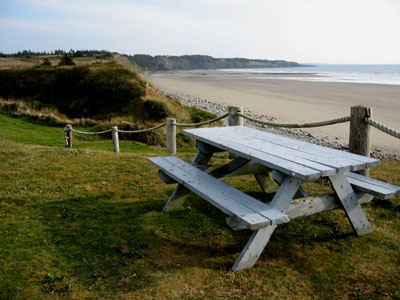
Nova Scotia shoreline
As the late afternoon sun was starting to cast long shadows I made
my way further south and drove along the rocky, sparsely treed coastline
and decided to follow a curvy road without knowing exactly where
it would take me. Fog was rolling in and the sky was becoming more
ominous. As the road came to a dead end I realized that I had arrived
at the Cape Forchu Lighthouse, with its rare apple core design,
which is situated on a dramatic coastline with interesting rock
formations.
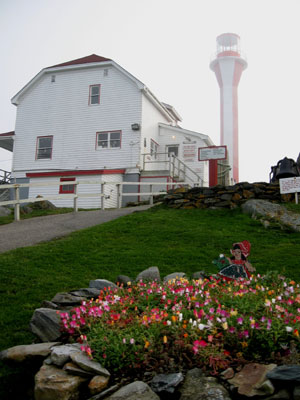
The Cape Forchue Lighthouse
The first lighthouse was constructed here in 1840 in order to protect
vessels entering the Yarmouth Harbour and today the complex is a
historic site. The little museum and gift shop were closed and the
lighthouse appeared rather lonesome on its rocky outcropping. The
dense blanket of fog gave it a very mysterious appearance.

Looking out into the fog
It was starting to get dark and it was time to drive into the town
of Yarmouth where I would be able to
settle in comfortably for the evening at the MacKinnon-Cann Inn,
a unique historical property. Time to check in…
Useful books about travel to Nova Scotia:
Related articles:
My five whirlwind days in Nova Scotia
Acadian
history at the Grand Pré National Historic Site
400 years of history at Annapolis
Royal
Port-Royal, a French habitation from 1605
Dinner at the Garrison House
in Annapolis Royal
The Annapolis Royal
Graveyard Tour
The Garrison House Bed and Breakfast
Exploring the Evangeline Trail from
Annapolis Royal to Yarmouth
Learning about Mi'kmaq heritage at the
Bear River First Nation Heritage and Cultural Center
Victorian heritage in Yarmouth
The MacKinnon-Cann Inn: Where Home
and Garden Television meets the Travel Channel
Yarmouth explained - the Yarmouth
County Museum
My car is in the ditch in Chebogue
River
The Lighthouse Trail from Yarmouth
to Shelburne
The Lighthouse Trail from Shelburne
to Lunenburg
The Town of Lunenburg - a UNESCO World Heritage
Site
An interview with the owners of the
Lunenburg Inn
The Lighthouse Trail from Lunenburg to
Halifax via Mahone Bay and Peggy's Cove
Arrival in Halifax and a stunning
musical performance - DRUM!
A Halifax city tour, the city's
connection to the Titantic and the 1917 Halifax Explosion
Exploring the Halifax Harbourwalk and
Pier 21 - Canada's immigration museum
A ferry trip to Dartmouth and saying
goodbye to Halifax
An interview with Pier 21 -
Canada's immigration museum
Helpful links for travel to Nova Scotia:
Tourism
Nova Scotia
Destination
South West Nova Scotia
Halifax Tourism
|